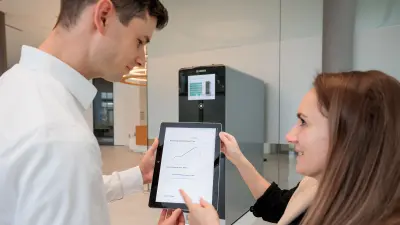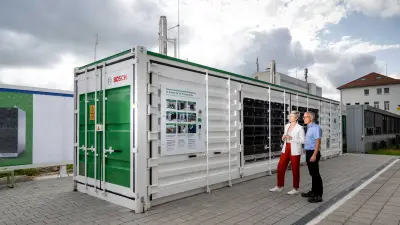Developing new business models with fuel cells
Stationary fuel cells are a key technology when it comes to the decentralized, climate-neutral energy supply of the future. A pilot facility at the Bosch plant in Salzgitter is not only laying the technical foundations for the hydrogen age, it is also experimenting with new usage models for SOFC fuel cells that don’t require the users to purchase the system. Instead, users only pay for the energy they consume and for using the system, thus safeguarding their liquidity. Partnering Bosch SOFC in the pilot project are Deutsche Bank and the Bosch production plant in Salzgitter. In addition to being the user of the new technology, the plant itself also produces the electronic control units for the system.

The advantages of SOFC fuel cell systems make them ideal for the decentralized supply of energy to industrial facilities, data centers, commercial buildings and even urban quarters.
One key benefit is that fuel cells generate energy where it is needed. This eliminates the need to transport energy across long distances via power lines. What’s more, decentralized energy production is less susceptible to disruption caused by network fluctuations and failures. However, not everyone who uses electricity wants to buy their own power plant. For many users, a better option is simply to pay to use the system and for the energy they consume – similar to the way electricity bills from network providers work.
Outside large-scale industry, at least, this is how the market has learned to operate, and this approach is expected to remain possible in the age of hydrogen and new energy solutions. The “SOFC as a Service” pilot project, or SOFCaaS for short, is conducting practical tests for an innovative financing and billing model at the Salzgitter Hydrogen Campus. A total of ten SOFC units supply electricity to the Bosch plant there. Five of the units were purchased, and are therefore the property of the location. Five additional units are financed by Deutsche Bank. The Bosch plant only pays for the use of the technology provided, which is billed based on consumption. This is the first practical test of the SOFCaaS model, which aims to market SOFC on a pay-per-use basis. Just like the short-term leasing of e-scooters in urban areas, users pay according to how far they ride or, in this case, how much they consume.
"With fuel cells, we are operating in the energy market,” explains Julian Schatz, who shares responsibility for business model validation and controlling with his colleague Florian Greppmair at Bosch SOFC.

Customers in the energy market are accustomed to using energy – particularly electricity in this case – without having to invest in the infrastructure to generate energy themselves. It is this customer demand that we are meeting through SOFC as a Service.
How SOFC as a Service works
As the name implies, “SOFC as a Service” doesn’t simply provide users with a power connection. Instead, they receive an entire package of real-world services, digital services and usage-based financing.
The innovative approach of the model makes it as straightforward and convenient as possible for users to receive a reliable power supply from the fuel cell system. It involves a pay-per-use model for the energy consumed, but also goes far beyond that. All technical and financing aspects are covered by the users’ contractual partners. The customer gets an SOFC system that is installed for them and proactively maintained to ensure it is always in optimum condition.
The partners in the model project are Bosch SOFC, which provides the technology, the Bosch plant in Salzgitter, which uses the energy, and Deutsche Bank. The last of these partners finances the system for the new as-a-service model and generates the usage-based invoices. Key goals of the pilot phase include testing the technical – and above all legal and financial – aspects for all the partners involved under real conditions.

Finance partner Deutsche Bank
The advantages for users are obvious – they get to use a technology of the future without tying up capital by procuring it. In the pilot project, Deutsche Bank has taken on the financing of the fuel cell system. Later, this can be secured using different financing models.
Unlike standard rental or leasing arrangements, users don’t even have to worry about integrating the system into their existing energy ecosystem. In the SOFC as a Service model, the technical contract partner takes care of this, along with energy management, maintenance, and – where necessary – proactive repairs. For the customer, this means the product is always in the best possible condition. In view of the guaranteed technical availability and the consumption-based billing, this model offers users clear cost advantages.
“Even simply the fact that there is no initial investment involved that has to be recouped makes SOFCaaS a lucrative model,” says Julian Schatz, highlighting one of the advantages for users. “On top of that, there are non-monetary factors such as the environmental benefits of the SOFC technology, the reliability of supply and the greater independence from electricity markets.”

Digital twin as a key technology
One core element of the business model is what is called the digital twin of the SOFC system. The control technology and sensors of the fuel cells transmit huge volumes of relevant operational data to a cloud, mirroring the system in a virtual environment.
The associates at the technical partner can use this data to monitor in real time whether the system is operating at an optimum level for the customer. In the near future, the digital twin is also set to make predictive maintenance possible. The benefits of this include an extended service life, less downtime, routine maintenance that is targeted and shorter, and the ongoing technical development of the products. What’s more, the digital twin sets the stage for the future scalability of the SOFCaaS model.
Deutsche Bank, the financing partner, also uses the digital twin. Based on the data it provides, the bank can automatically bill usage charges, analyze consumption behavior and optimize the financing solution. “The digital twin does not just help us determine the costs automatically for customers – it also provides us with the consumption data essential for as-a-service models. Based on that, we can develop sustainable financing models,” explains Anne-Katrin Brehm, who is responsible for financing solutions for as-a-service business models at Deutsche Bank. “The better we understand how different SOFC systems are used across different industries, the more customized and sustainable we can make the consumption-based approach for financing and billing.”
The pilot plant in Salzgitter is operating in an industrial environment. The SOFCaaS model can be used in many settings, such as data centers, buildings and urban quarters. On the capital injection side, the financing partnership in the SOFCaaS model will primarily be of interest for institutes and investors looking to invest in sustainability.
An overview of SOFC as a Service
A total of ten SOFC units are in use at the Salzgitter location. Bosch and Deutsche Bank are using five of them to test the SOFC as a Service, or SOFCaaS, offering. The innovative approach embodied by this concept is that, instead of buying the entire system outright, users pay only for the electricity they consume, their use of the system, and the associated services. The advantage for users is that they get to utilize a technology of the future without tying up capital by procuring it.
Goals
To set up a new business model for the innovative fuel cell technology.
Area of application
Decentralized electricity supply in an industrial setting. The model is transferable to other areas.
Location of use
The Bosch location in Salzgitter, which manufactures control electronics.

SOFC as a Service is an innovative financing and business model for us at Deutsche Bank. The digital twin is of vital importance in this. It does not just help us determine the costs automatically and accurately for customers – it also provides us with the consumption data essential for as-a-service models. Based on that, we can develop sustainable financing models.
- SOFC units installed at the plant
- kW (nominal) of electrical energy
- kW of thermal energy
- percent of the plant’s electricity requirements are covered
- start date for the first SOFC systems
The Bosch SOFC system is currently in the pilot phase. All technical specifications given are development objectives and refer to the beginning of life.






